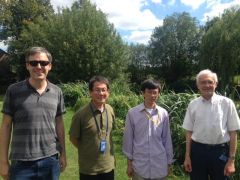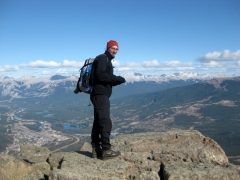
| Ji Qiang
from Lawrence Berkeley National Laboratory visited the Intense Beams
Group at Rutherford Appleton Laboratory to discuss simulation aspects of
high intensity beams. Ji is the author of the IMPACT code, a
well-established simulation tool. A seminar covering the latest IMPACT
developments was presented with examples of simulation models of high
intensity, high brightness beams. |
|

| Wenchen Gu
is a Year 11 student from Magdalen College School in Oxford. He spent a
week with ASTeC Intense Beams Group as a work experience student.
During this time he learned to code in Python and developed scripts for
calculating various accelerator parameters in the CERN PS. His final
presentation was received very well by the entire group. |

| Raymond Wasef
is a PhD student working at CERN studying resonance compensation and
high brightness beam dynamics in the CERN PS under the supervision of
Simone Gilardoni and Giuliano Franchetti. As part of an ongoing
collaboration, he recently visited the Intense Beams Group at RAL for
extended discussions with members of the group and in particular Shinji
Machida, on a recent study of space charge induced resonances. |

| Max McGinley
came to RAL from the University of Cambridge to work on MICE with the
ASTeC Intense Beams Group for two consecutive summers (2014 and 2015).
Max studied solenoidal beam optics and perturbation theory, helping to
develop a Lie algebra based code to study non-linear emittance growth in
the MICE lattice. |

| Staff in ASTeC and ISIS were deeply shocked by the news of Christoph’s untimely death at just 40 years of age. Working
across both divisions at RAL, Christoph was recognised as an
established specialist in the accelerator field, particularly in H-
injectors and non-destructive beam diagnostics. Christoph joined RAL in August 2006... |

| Stephen Brooks was a member of ASTeC Intense Beams Group until October 2013 when he accepted an appointment at Brookhaven National Laboratory.
However, we continue to collaborate on a number of topics including
high power proton accelerators, optics design, novel FFAGs, code
development, etc. For more details, please visit Stephen's website at stephenbrooks.org |

| Jim Stovall visited
the Intense Beams Group at Rutherford Appleton Laboratory to discuss
various design options for the ISIS Upgrade Linac. RF as well as beam
dynamics issues were covered. An informal meeting was also held with
members of the FETS team to discuss aspects of RFQ modelling and
manufacturing. Additionally, Dr Stovall gave a seminar outlining the conceptual design of an injector linac for the Chinese Institute of Atomic Energy. |

| Hideaki Hotchi, Hiroyuki Harada and Shinichi Kato
from J-PARC visited the Intense Beams Group to discuss modelling
aspects of high power synchrotrons. This was their second visit at
Rutherford Appleton Laboratory, after a very successful visit last year.
Exciting experimental results from the J-PARC RCS were presented that
lead to updating our simulation tools (Simpsons). J-PARC RCS Beam Commissioning and Operation Status - H. Hotchi Optics Tuning of the 3-50 Beam Transport Line at J-PARC - H. Harada Tune Spread Measurement - S. Kato |

| Massimo Giovannozzi
(CERN) visited the Intense Beams group from July 2-5, 2013 to discuss
potential collaboration on a number of topics related to beam dynamics
in the CERN PS. His visit prompted stimulating discussions of the
physics of intense beams, focussing on novel beam splitting techniques
in which particles are trapped in resonance islands in phase space.
After visiting ISIS, MICE and FETS, he delivered a seminar on the manipulation of transverse beam distributions in circular accelerators. |

| François Méot
from BNL visited the Intense Beams group. Stimulating discussions took
place on a number of topics ranging from FFAGs to novel accelerators and
ideas were put forward for possible collaborations. During his visited
he was also taken on a tour of ISIS and some of the instruments as well
as Diamond and the Front End Test Stand.
|

| Thibault Shadman
joined the Intense Beams Group as a summer student from the University
of Paris Diderot. His main project was understanding, modelling and
optimising the ISIS Muon Beamline, in preparation for a proposed major
upgrade. Working closely with more senior members of our group, he
developed a matrix tracking code for this purpose. Written in Python,
the code transports particle coordinates through a series of drifts,
quadrupoles and dipoles allowing the user to investigate problems such
as beam loss and potential improvements.
|

| Alison Mitchell
joined us for 10 weeks as a summer student from the University of
Warwick. Alison created complex simulation models of the ISIS linac,
investigating various beam dynamics issues. In particular, she studied
the beam loss along the linac and tried to explain the observed level of
loss in the ISIS machine. One of the achievements was finding that by
adding a relatively short matching section between the RFQ and the first
DTL tank the transmission can be dramatically improved. In addition,
she simulated the proposed 800 MeV ISIS upgrade linac, comparing
different codes and highlighting the major differences and challenges in
accurately modelling the linac.
|

| Dr Andreas Adelmann
is the group leader of the Accelerator Modelling and Advanced
Simulations (AMAS) group at PSI. His main research interests are in the
areas of multiscale beam dynamics and related numerical methods, large
scale multiobjective optimisation and high performance computing. One of
his main projects is the OPAL (Object Oriented Parallel Accelerator
Library) C++ framework for particle accelerator simulations, which he
has recently helped install at RAL. Suzie Sheehy will use this code to
pursue simulations of high power proton FFAGs, and collaborate in future
code development. While visiting, Andreas also presented a seminar on
the OPAL code and recent simulations of the PSI 590 MeV cyclotron and
SwissFEL.
|

| Thomas Guitton
joined us for 4 months as a summer student from the University of Paris
Diderot, supporting work on software and analysis for the MICE project.
Thomas investigated the effects that RF cavities will have on the muon
beam, studying the size and shape of the RF bucket and the amount of
acceleration that will be produced. He went on to model the features
that might be observed in the event that RF cavities are incorrectly set
up within the MICE beamline, how this can be seen in the presence of
complex real world effects and understand how the set up may be
corrected.
|

| Seira Aoto
is a sixth form student from Winchester College. He spent a week with
the ASTeC Intense Beams Group learning about particle accelerators. As
part of his project here, he also helped writing a Python code that
could be used to read and analyse accelerator data.
|

| Prof Robert Jameson and Dr Johannes Maus
from Goethe University in Frankfurt recently visited ASTeC's Intense
Beams group at RAL. Prof Jameson is an internationally renowned
accelerator physicist, who was a pioneer in RFQ design. He has extensive
knowledge of space-charge dynamics and other high-intensity effects for
bunched beams in ion linacs. In collaboration with Dr Maus, he has
recently developed a new code for RFQ design and modelling. The
discussions at RAL concentrated on topics related to the FETS RFQ and
the ISIS upgrade linac. In addition, two seminars were given on beam
halo studies and code development.
|

| Dr David Neuffer
of Fermilab was one of the pioneers of ionising cooling as a technology
that could be used to accelerate muons and invented the muon capture
scheme that is now the baseline for both the Neutrino Factory and Muon
Collider design. Together with Chris Rogers, he is coordinator for the
muon front end working group, with the aim of developing a conceptual
design report and costing for the muon front end.
|

| Dr Gersende Prior
is based at CERN where she works on the Neutrino Factory as part of the
EURO? conceptual design study for a future Neutrino Facility in Europe.
She often visits our group to collaborate on the Muon Front End.
|

| Dr Toru Ogitsu works at KEK where he is the Cryogenics Section leader. He has visited our group in June 2009 giving a seminar on the "Superconducting Magnet System for the J-PARC Neutrino Beam Line".
|
